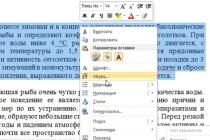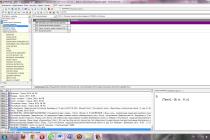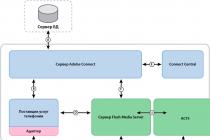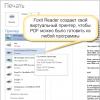In Yandex.Webmaster, you can add a site that works both on the engine (WordPress, Joomla, Drupal, etc.), and a site laid out on "bare" HTML.
Step 1. If not account on Yandex, then we create it, if there is, then we log in to any service (for example, mail).
Step 3. We click on the button with a plus sign - "Add site".
Click on the "Add Site" button
Step 4... For Yandex, the sites listed below are different:
- https: // site
- http: //www.site
- https: // site
- https: //www.site
If you add a site without specifying a protocol - a site, then Yandex will decide that we are talking about a site https: // site, i.e. about the site working on the unprotected http protocol. In order not to be mistaken, just copy the address of the main page of the site from the address bar of the browser and paste it into the form field.
 Insert the site address and click the "Add" button
Insert the site address and click the "Add" button At the time of this writing, my blog is still working on the http protocol, but very soon it is planned to transfer it to a secure one. https protocol, which will be devoted to a separate article.
Step 5. Now it is necessary to confirm the rights to the site. This can be done in four ways:
- Adding a meta tag to the code of the main page of the site;
- By uploading an html file with the specified name to the root of the site;
- Adding a TXT record to the DNS of the domain;
- Confirmation of WHOIS via Yandex.Passport.
It just so happened "historically" that I confirm the rights to sites by uploading to the root of the file (earlier it was possible to upload txt files, now only html files) - I will consider this particular option.
 Go to the HTML file tab and download the confirmation file to the local computer by clicking on the corresponding link
Go to the HTML file tab and download the confirmation file to the local computer by clicking on the corresponding link Now the file must be uploaded to the root of the site, i.e. where the index.php (WordPress site) or index.html (HTML site) file is located. In a specific case, I used file manager hosting Beget.
 html file is located in the root directory of the site next to index.php and robots.txt
html file is located in the root directory of the site next to index.php and robots.txt Now it remains to check whether the html file is being downloaded from the specified link. To do this, just click on the "Check" button.


Hello dear readers of the Anatomy of Business project. With you, as always, webmaster Alexander, and today we will talk about how to connect your site to Yandex.Webmaster and why you need it.
We'll start, perhaps, directly from connecting the site. The first thing we need to do is go to the Webmasters section on Yandex. After we have entered this section, we click "Add site".
An interface opens in front of us, in which you need to enter the address of our site and click the add button:

In the next step, you need to confirm that you are the owner of the site. There are only four ways:
- by placing the html file with the verification code in the root folder of the site,
- by placing on home page meta tag with verification code,
- by placing a txt file in the root folder, the name of which will contain the verification code,
- by registering the data requested by Yandex.
As for me, so the most in a simple way is the placement of the html file in the root folder.
This can be done via an FTP connection. How to connect to a site via FTP, I wrote in this article.
Place the file and click "Check"! If the file is placed correctly, then our site is connected!
Overview of the main panel in Yandex Webmaster
Immediately after confirmation, the following interface opens in front of us:

"Pages in search"- the total number of pages on your site that are currently in Yandex search.
"External links to site pages"- the number of links from other sites. Only sites where ordinary users cannot post links, i.e. social networks and forums are not displayed here.
"Date last visit site by a robot "- everything is clear.
"Loaded by a robot"- the total number of pages that were downloaded by the robot.
"Excluded by the Robot"- the number of pages that were excluded by the robot. Be sure to keep track of this indicator. In my memory, there was a case when the site was hacked and a year was sewn into it, which prohibited the indexing of the site by search robots. It was from the sharp jump in the pages that took off from the search that I realized that something was wrong with the site, and was able to take timely measures.
"TIC"- citation index. The expanded value of this indicator can be read by clicking on it in the Webmaster's panel. Speaking simple language, this indicator increases with the enthusiasm of the number of high-quality sites linking to you. Previously, this indicator played a decisive role in the ranking of search results. But now search engines pay more attention to behavioral and social factors.
Left column overview. Site indexing

"Site structure" - in this section Yandex.Webmaster displays the headings and sections of your site in which the largest number of pages is located.
"Excluded Pages" - pages removed from the SERP. In this section, you can also track why a particular page was removed from the SERP.
"History" - here, one might say, all information about the history of indexing of your site is stored.
Indexing settings + search queries

"Analysis Robots.txt" - allows you to analyze robots.txt for errors.
"Sitemap files" - thanks to this section it is possible to both check the presence of this file on the site, and download this file to your site!
"Main mirror" - here you need to indicate what type of URL we are promoting: with or without WWW.
"Popular searches" - in this section, we can see for which queries Yandex shows us in the search results.
"Request History" - tracking the history of the request: the number of impressions, clicks, CTR, etc.
"My Regions" - displays the regions where your site is shown.
"My requests" is a very interesting functionality that allows you to enter those requests that interest you the most through the "Settings" section. After that, detailed statistics on these requests will appear in the "Statistics" section.
Site geography + site content

In the "Site Geography" section, you can indicate the geographic origin of your site. This item must be indicated for regional projects. If you have a resource designed for the whole of Russia, you need to indicate that the site does not have a geographic reference.
Site Content is also a very useful service. Many sites face constant content theft. While Google indexes almost instantly, Yandex needs a fairly long period of time for this (sometimes it can take up to 1-2 weeks). In order to claim the authorship of the article, you just need to enter your texts through this section.
As we can see, this service is very useful for a webmaster!
I strongly recommend that you use it to track the main characteristics of your resource!
If you have any questions, ask them in the comments! I will gladly answer!
Greetings, my dear friend! Today we will tell and show you how you can
independently add a site to Yandex Webmaster. Why is this done? This is done so that Yandex indexes your site and all its new pages faster, to protect unique content from theft, check the site for errors, as well as to further evaluate the effectiveness SEO promotion .
So let's get started. We hope you already have a website and you want to see it on the first lines of search engines as soon as possible. Well, well, then go bolder!
We add the site to Yandex Webmaster on our own
To get started, you need a Yandex account. If not, then just start a work mail, it will definitely not be superfluous for you. Go to the mail and select the item "More", then in the menu that opens "All services".
On the page that opens, scroll down a little and under the letter "B" select the item "Webmaster".

After we went to the Webmaster's page, a wonderful-looking panel opens in front of us. Click the plus sign at the top right to add a website.

In the field that opens, enter the address of the site that you want to add and click "Add".
After that, Yandex will ask you to confirm the rights to the site. We recommend using the first method and place the meta tag on the site in the code between and .

When the rights to the site are confirmed, you can study the Yandex Webmaster tools in more detail.
The main tools of the Yandex Webmaster panel
So, let's take a look at the basic Yandex Webmaster tools that will be useful to you at the initial stage of working with the site.
Diagnostics
Website diagnostics.
Here you will find information about errors on your site, as well as Yandex recommendations for correcting them. By following them, you can significantly increase your position in the search results.
Examples of errors:
- missing meta tags;
- no sitemap;
- no robots.txt file;
- long server response;
- the region of the site is not specified, and so on.
If problems are found, they will be displayed in this tab, below there will be a link to a page with ways to fix it.

Security and Violations.
Information in this section may inform:
- about threats emanating from the site;
- about violations of the rules by the site search engine Yandex.
Threats. For example, the presence of malicious code on a website that triggers multiple redirects, displays ads, contains a virus, etc.
Violations. You can see the entire list of violations in the Webmaster documentation. The most common violations include: doorways (redirecting to other sites), low-quality and non-original content, hidden text, cloaking.
Search queries
Here you can find information on:
- history of requests;
- recent requests;
- and recommended queries.
Let's deal with each of the points.
History of requests.
The section contains information about the number of site impressions in the search results when users request, the number of clicks from the search results, the average display position, the average click position and even the CTR! By the way, an impression is considered to be the presence of a site on the search results page, which the user opened.
For example, if your site is on the 3rd page of search results for the query "website creation", and the user only looked at the 1st and 2nd pages, the site will not be counted as impressions.

Requests for which you are moving can be selected in a separate group (favorites) or you can view statistics for each of them separately, simply by clicking on it. There are also popular queries (for which your site is most often shown in search) and trends (dynamics of site traffic growth, relative to competitors).
Recent requests.
The section shows the requests for which the resource is on the first 50 lines of Yandex search results. Opposite each request is data for the last 7 days: impressions, clicks, position, CTR. If you do not see statistics for the required queries, you can add them manually. The most important queries for monitoring can be selected as Favorites or create a new group by position or topic.
Click "Create Group" and enter a name.

Then add requests to it by filtering conditions ("Add filter") or upload your requests manually (the "Load requests" button).

Going to the section, click on the button "Get Recommended Requests" and within a few days you will receive a list with requests that we recommend using Yandex itself to increase search traffic.
Indexing
In this setting, you need to add a Sitemap, as well as specify a region or several (maximum 5) by which the site will be promoted.
Crawl statistics.
The tab contains information about the status of the site pages obtained as a result of crawling by the Yandex search robot. Viewing crawl statistics allows you to identify problems with loading certain pages or sections of the site ( All pages), as well as find out which pages the robot has recently crawled ( Last changes).

The statuses that can be obtained as a result of the bypass are displayed as a code in the format: 2xx, 3xx and 4xx. Codes starting with number 2 speak of Success, from number 3 - about forwarding, from number 4 - about an error.
The main thing what you should pay attention to so that there are not many pages that respond with an error or redirects. If such a situation has arisen, check the correctness of your server and the absence of errors on the site pages (for example, a ban on indexing or malicious code).
Search pages.
The next, according to the logic, are the pages that are in Yandex search, that is, those that the robot crawled, indexed and shows in the search results at the request of users.
In the section you can find information about recent changes(deleted and added pages), all pages and excluded pages.

Here important to track so that the most important pages of the site do not disappear from the search - this can happen, as by mistake on the part of Yandex ( this happens very rarely), and on the part of website developers (such incidents happen much more often). For example, the url of a page could have been changed, but redirection was not configured, as a result, the site loses traffic, and the page is excluded from the search.
Site structure.
Want to know how a search engine sees the page hierarchy of a resource? Take a look at this tab.

You can also add your own section here. But, if you do not know why to do this and have never done this before, it is better not to experiment and leave everything as it is.
Check url status.
To check how any of the pages on the site is responding and whether it is currently being searched for, go to the Check URL Status section. Paste the URL of the checked pages into the text field and click check "Check".

To get more detailed information - click "Details" on the right.
Important pages.
Above, I wrote about the fact that it is extremely important to track the pages that bring the most visits or are important from a commercial point of view. But to go every day to Yandex Webmaster and check if their status has changed, the lesson is quite necessary and useless. It is enough to mark the necessary pages as "Important" ( pages can be entered manually or selected from Yandex recommendation) and set up notifications (button at the top right).

Put a bell in front of those positions about the change of which you immediately want to receive a notification on email.
Re-traversing pages.
This is one of the most useful dashboard tools for webmasters in Yandex. It allows you to speed up the indexing of new or updated pages on the site. I usually do this as soon as I published an article on the site, I immediately put it on re-bypass. If the topic of the article or news is new, and there are no publications on this topic on the Internet ( yes, it happens), then it can appear in search results within a few hours. In other cases, the indexing process takes several days.
The limit on page traversal is no more than 20 per day. Copy the url of the page, paste it into the text field and click "Submit". Everything is extremely simple.
Sitemap files.
From the name it immediately becomes clear why this section is needed. That's right, in order to indicate to the search engine where we have a sitemap. Go in, write a link to your sitemap and click "Add".

Moving the site.
This section can be useful in the following cases:
- the site is moved to the new url.
- you connect the https security certificate.
- it is important to specify or change the main mirror of the site.
Each of the above points is a topic for a separate article, which you will soon be able to find in our blog.
Links
Internal links.
External links.
Here you can also find the TIC of referring sites and data on domain zones. The section is useful in that it displays links that it sees, and, accordingly, takes into account Yandex.
Information about the site
Turbo pages.
If you want when searching with mobile device Yandex showed users not ordinary pages, but accelerated ones, the content on which is loaded instantly, then you need to configure this tool.
Regionality.
Specifying the region is especially relevant for local companies that promote their business within one or more cities or regions.
Hello friends. The development of a new project on the Internet is a whole science, it begins with indexing - this is when search engines find out about new pages and add them to their database. Among all the ways to ensure fast and complete indexing, the first place is to add a site to search engines through special services. Today I will tell you in detail how to add a site to Yandex through the Webmaster's panel of this search engine and make the settings necessary for correct operation.
What is Yandex Webmaster for?
From the very beginning, Yandex Webmaster was created as a tool connecting the site administrator with a search engine - this is a panel through which Feedback, where you can see all the changes taking place with the resource. Using the panel, you can:
- diagnose and see errors,
- see how the robot perceives the page data,
- check what responses the server issues to requests,
- improve appearance in search results,
- view the indexing results and speed up getting into the index of important pages,
- find out for what requests visitors come and the dynamics of clicks,
- specify the region of the resource,
- and other.
As you can see, the range of applications is wide and, even if you have no problems with indexing, you must add the site to Yandex Webmaster.
How to add a site to Yandex
To work, you need an account on yandex.ru, you need to have an email on this service.
Go to the address - webmaster.yandex.ru
On the page you will find several buttons "Login", click any.
Webmasters will contact the account you are currently logged into or offer to log in with any other.
Until the first site appears in the panel, you will see a welcome text inviting button "Add site", subsequently, when connecting new resources, use the plus button at the top of the panel.
The domain address must be entered with the protocol (http or https) and the prefix (if you are using a site with www) - formally, these are different sites, although they are, as a rule, mirrors of each other.
Proof of ownership
Only the owner can see and manage domain information in search results. The next step is to confirm ownership of the resource.
The panel for webmasters allows you to do this in three ways:
- Meta tag in the page code;
- HTML file in the root folder of the site;
- DNS record.
The last point is the most difficult, so few people use it and I do not advise you.
Option 1. Meta tag
The easiest way is to write a special verification code (meta tag) in the head section. Put the code right before the closing tag on the home page.
Make changes, click "Check" and if the Yandex robot finds this code on the page, then the rights will be confirmed.
Option 2. HTML file
The second option is also simple and suitable for those who are afraid to edit something in the source code themselves. You need to create a text file with the given name and html extension, it starts with yandex_, and then an individual set of characters. Copy the code from the page inside the file, save.
Then we send the robot for verification.
As a result, you will see a table with a list of users allowed to access information on the site. initially there is only your username, and if you wish, you can add any other user through the "Delegate rights":
Yandex Webmaster will start collecting data on your resource and after a while they will be displayed in the panel - you have added the site to the search engine.
Site settings in Yandex Webmaster
The service will do almost everything that needs to be done on its own - it will scan the site, find errors, add pages to the index, monitor the appearance of new ones, but if it is not helped, it can take a lot of time.
What you need to do right away:
1. Checking Robots.txt via Yandex Webmaster
This file is responsible for allowing / denying directories and individual pages of the site to be added to the search base.
To check whether Yandex sees it and how the directives are perceived in the left panel of Yandex Webmaster, find the item “Tools” -> “Analysis of robots.txt”.
Here you will see how Yandex sees the file, what lines are being read, check for yourself whether the correct folders are closed, whether important sections are open, whether the xml address of the sitemap corresponds to its real location (whether the protocol matches).
You can read how to properly compose a Robots file in.
2. Adding sitemap.xml to the Yandex panel
Sitemap.xml is a file with a list of links to all pages of the resource that should be included in the search. By scanning it, search engines determine the priority targets for indexing. This file is especially relevant for large projects.
Adding a file address to the webmaster panel significantly speeds up page indexing.
This tool is located in the item "Indexing", under the link "Sitemap files". The first time you will see only an empty form inside - paste the link to the file into it and add.
After scanning, opposite each xml file(there may be several of them) the status and the number of links found in it will be indicated.
3. Fast re-indexing of pages
This function is needed for hints search robots- which pages need to be re-indexed in priority order, for example, after making important adjustments or when new URLs appear.
Located in the section “Indexing” -> “Reversing Pages”:
Add URLs and click submit.
4. Set the regional affiliation of the site
Yandex itself determines which target audience the resource broadcasts, but it may be wrong, it is better to set such things yourself. If the resource is not geographically linked, then you should specify “No region”.
To specify in Ya.Webmaster, go to the “Site Information” tab, there “Regionality” and click the gear next to the “Webmaster” inscription.
After updating the search base, geotargeting will take effect.
5. Set the case of the site name in the search
The case is responsible for how the URL looks in the search results - uppercase or lowercase. This is especially true for domains containing multiple words.
Going to the item “Register of site name” in the menu “Information about the site”, you can set up any format for each letter of the domain.
The address turns out to be more readable, which has a positive effect on the number of clicks in the search and, accordingly, on the promotion.
Yandex.Webmaster Is a kind of Internet explorer in conjunction: you - your site - the Yandex search engine. It appeared in the public domain back in 2007 and since then has become an indispensable assistant to the optimizer!
What is Yandex.Webmaster for?
Using the Yandex.Webmaster service you broadcast to the Yandex search engine that somewhere in the depths of the Internet a site has appeared, to which it would be nice for him to turn his gaze.
The starting point, as always, will be the registration of an account in Yandex, in other words, mail, which will become your login. Everything is simple here. =)
Further, the task becomes more complicated. Yandex will need to get confirmation that the site really belongs to you. To do this, a choice will be offered to a number of manipulations with the site, confirming your rights. We'll take a closer look at this point later. In the meantime, we continue to enjoy the sightseeing tour!
Why add a site to Yandex.Webmaster?
In the first block of the Webmaster, « general information» , - displays all summary statistics about how many pages of the site are in the search, about its external and. Site visit dates Yandex robot how many pages loaded(it is important to consider that they can be downloaded but not indexed yet) as well.
Information about the site in the Yandex.Webmaster service
Website URL check
In this section of the service, you can check the indexing of a specific page of the site. To do this, you just need to enter its address in the line, as in the picture below:
How to check if a page is indexed by Yandex?
At first glance, the simple functionality of this option can actually be very useful. We will consider the not obvious capabilities of the URL validation function in Yandex in our next article =)
Site indexing
It is important that Yandex index the site correctly and quickly, and also present it in its search results.
To find the desired page and index it, the Yandex robot must get to it. He can do this by going to the desired page using a link from another page of the site. Therefore, special attention should be paid to competent development of the site structure. You can check how Yandex perceives the structure of your site in the subsection Site structure.
Site structure in Yandex.Webmaster
It will not be superfluous to pay attention to the fact which pages are in the search.
Below is an example of how search pages should look.
Subsection "History"
Yandex stores the history of the robot's calls to the site. On the "Number of requests" tab you can track the graph of the server's response, in other words, the availability of the site pages accessed by Yandex.
Below by opening the "HTTP codes" tab, you can see in more detail what kind of response code Yandex received by accessing a particular page. The green "OK" scale speaks for itself, the blue one with the 3xx parameter is the server response, meaning redirection, 4xx is an access error in the client request, the most common 404, and 5xx is the server error response.
It looks like this:
Checking the server response code in Yandex
Setting up indexing
Competently spelled out map of site Is another important tool for correct indexing,.
All this is needed to improve the speed of site indexing and to properly use the search engine resource allocated for your site.
Site mirror
To prevent the site from disappearing into the abyss after gluing, we set up the main mirror in the Webmaster.
- First, you need to define the main domain, it can be either with the WWW prefix or without. If you do not specify the main mirror, Yandex will choose the main mirror itself, and in this case all links installed on a non-main mirror will simply have no weight.
- Secondly, if you have several domains with different addresses, but duplicate content of each other by 80 percent or more, indicating the main mirror is a matter of vital importance, otherwise there is a chance to be branded as a fraud and completely drop out of the search results!
Search queries
You can see what queries you most often show up in the search by opening "Popular queries" in the left menu. We will come back to the question of statistics and tuning requests for tracking.
Site geography
Be sure to indicate the region of the site in the "Site geography" field, this can significantly affect the search results in the city you need. In addition, Yandex uses different ranking methods when considering regional affiliation.
Site content
Adding text content to Webmaster
Having copied the text from the site and loaded it into the pop-up window, we will indicate to the search engine that we are the author of the content, this will insure us if the page has not yet been indexed, and someone cunning has already copied and pasted our works for himself.
Site in search results
The choice of "Quick links" in the "Site in the search results" section can only be influenced in a recommendatory manner, since Yandex chooses them by itself, determining the most popular.
However, you can still help Yandex to correctly select the sections of the site you need by using the list of simple tips =)
The Site Name Register tool is necessary if you decide to change the spelling of the site address by adding, for example, a couple of capital letters - this will not affect the ranking in any way.
Security
Yandex cares about your safety, so it will notify you if it detects malicious code on the site. The message will appear in the "Security" block.
Management rights
Well, you can delegate the rights to manage the site by specifying the Yandex username in the line, as in the picture below:
Add a user to manage the site in the Webmaster
It will come in handy when you are, in order to bring all jewelry optimization settings to perfection with our reverent participation!
See you soon on the air!














